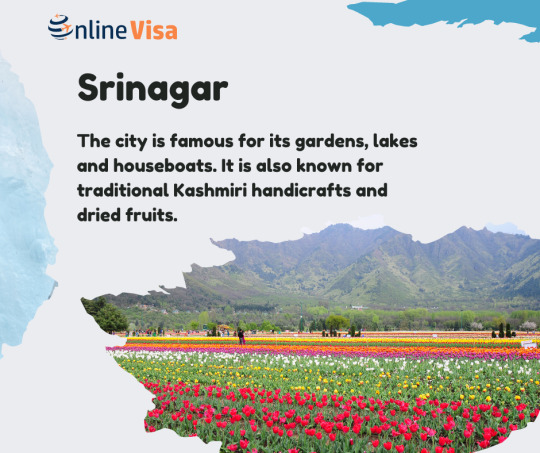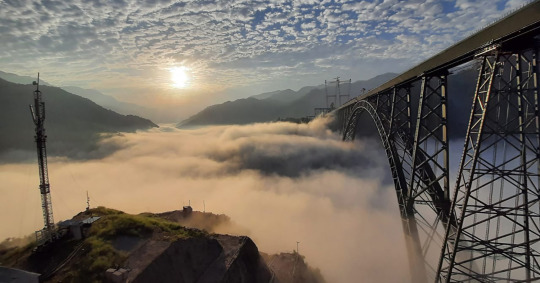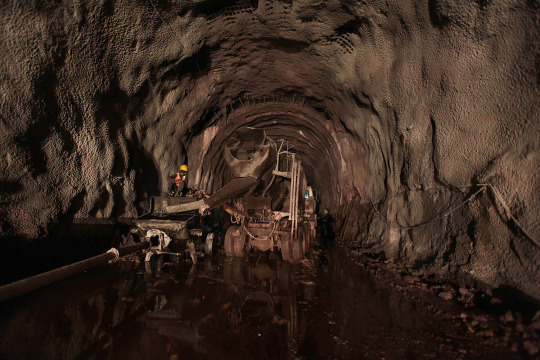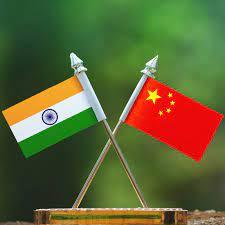#ladakh face-off
Text
Ladakh standoff: Military talks between India-China frank, in-depth; focus was on resolution of issues, says joint statement | India News
Ladakh standoff: Military talks between India-China frank, in-depth; focus was on resolution of issues, says joint statement | India News
India-China Border Row: Amid the tense situation along the LAC, India and China today held the 17th round of military talks on the eastern Ladakh row. According to a joint statement, both sides agreed to maintain stability on the ground. The joint statement said that the talks were frank and in-depth while the focus remained on the resolution of remaining issues.
“The 17th round of the…

View On WordPress
1 note
·
View note
Text
During the recent G-20 summit in Bali, Indonesia, Indian Prime Minister Narendra Modi got up from the banquet table to shake hands with Chinese President Xi Jinping and have a brief conversation—their first in-person exchange in three years. Although both sides remain tight-lipped about the interaction, it nonetheless raised hopes among observers of a breakthrough in their 30-month border crisis, which began with a deadly clash in Ladakh in 2020. But any resolution that might emerge will not dispel the challenge posed by massive changes at the border undertaken by China’s People’s Liberation Army (PLA).
This marks the third straight winter that around 50,000 Indian reinforcements will spend in Ladakh’s inhospitable terrain in the northern Himalayas, warding off an equal number of Chinese troops stationed a few miles away. Despite intermittent dialogue between the two militaries, Indian Army Chief Gen. Manoj Pande recently confirmed that China has not reduced its forces at the Line of Actual Control (LAC). Chinese infrastructure construction along the border is “going on unabated,” he said—confirmed by independent satellite imagery and echoed by the latest U.S. Defense Department report on China. Pande said the situation is “stable but unpredictable.” That unpredictability has become structural.
India and China have so far held 16 rounds of border talks between senior military commanders as well as numerous diplomatic and political engagements, but an agreement on actions to reduce the tensions in Ladakh has been slow to materialize. Of the seven areas in Ladakh where Indian and Chinese soldiers have faced one another since 2020, two have seen no change while the rest have seen each side take a limited step back. The challenge for India is becoming more concerning on the eastern part of the LAC—between the state of Arunachal Pradesh and Tibet—where China has an infrastructure and military advantage, putting New Delhi on the defensive.
The widening power gap between India and China—military, technological, economic, and diplomatic—now constrains New Delhi’s options on the border. It also raises tough questions for India’s geopolitical partnerships, such as the Quadrilateral Security Dialogue (known as the Quad), and its aggressive approach toward Pakistan. The border crisis will hang over India’s decision-making for the foreseeable future.
In October, the Chinese Communist Party held its 20th National Congress, and Xi assumed an unprecedented third term as leader. Among the images broadcasted at the Great Hall of the People minutes before Xi ascended the stage was a video from the Galwan Valley in Ladakh, where at least 20 Indian soldiers and 4 PLA soldiers died in a clash in June 2020. The videos showed PLA regiment commander Qi Fabao standing with his arms outstretched to stop Indian soldiers from advancing. Qi was selected to be a delegate to the Party Congress, underlining the importance of the border crisis to the Chinese Communist Party’s narrative. Harnessing nationalism, the party wants to convey that it will protect what it considers Chinese territory at all costs.
India’s military and political leaders now confront a reality at the border that should have jolted them into serious action: China has a distinct advantage over India, which it has consolidated since 2020. By investing in a long-term military presence in one of the most remote places on Earth, the PLA has considerably reduced the time it would need to launch a military operation against India. New military garrisons, roads, and bridges would allow for rapid deployment and make clear that Beijing is not considering a broader retreat. The Indian military has responded by diverting certain forces intended for the border with Pakistan toward its disputed border with China. It has deployed additional ground forces to prevent further PLA ingress in Ladakh and constructed supporting infrastructure. Meanwhile, New Delhi’s political leadership is conspicuous in its silence, projecting a sense of normalcy.
Beijing refuses to discuss two of the areas in Ladakh, where its forces have blocked Indian patrols since 2020. In five other areas, Chinese troops have stepped back by a few miles but asked India to do the same and create a no-patrolling zone. This move denies India its right to patrol areas as planned before the border crisis began. The PLA has flatly refused to discuss de-escalation, in which both armies would pull back by a substantive distance. The question of each side withdrawing its additional troops from Ladakh is not even on the agenda. A Chinese foreign ministry spokesperson rejected any demand to restore the situation along the LAC as it existed before May 2020. The PLA continues to downplay the severity of the situation, instead emphasizing stability in its ties with India.
If the situation in Ladakh is “stable but unpredictable,” Indian military leaders have told Foreign Policy that major stretches of the LAC’s eastern sector—2,500 kilometers (or 1,553 miles) away—are an even bigger cause of concern. In 1962, this area was the site of a humiliating defeat of the Indian Army at the hands of the PLA. Today, massive Chinese infrastructure development and troop buildup closer to the LAC has placed India at a military disadvantage. In September, Pande said when it comes to infrastructure in the area, “there is lots to be desired to be done.” Recent reports suggest at least three additional PLA brigades remain deployed in the area even after the Party Congress, further worrying Indian military planners.
China officially claims the entire state of Arunachal Pradesh, which includes the Tawang Monastery where the sixth Dalai Lama was born in 1683. Tawang was historically a part of Tibet; Chinese officials, such as Dai Bingguo, who served as China’s boundary negotiator with India from 2003 to 2013, have publicly stated that it would be nonnegotiable in a permanent settlement of the disputed border. As questions arise over the succession of the current Dalai Lama, who is 87 years old, Chinese sensitivities about Tawang will intensify—even more so when linked to its internal security problems in Tibet. In the coming years, it is likely to become a higher priority for China.
Still, it is in Ladakh that the Chinese have built up infrastructure at a frenetic pace, with only military operations in mind: roads, bridges, airfields, heliports, accommodations for troops, and storage and communication infrastructure. Pande noted that one of the biggest developments is the G695 highway, which runs parallel to the LAC and gives the PLA the ability to quickly move from one valley to another. Flatter terrain on the Chinese side already gives Beijing an advantage, now further bolstered by infrastructure—an extensive network of new roads, bridges, and heliports.
In the 1960s, the PLA needed one full summer season to mobilize and launch military operations in Ladakh for the next summer. Now, it would need a couple of weeks to undertake the same operation. Indian military planners must live with this scenario, even if the current border crisis is resolved.
Modi approaching Xi in Bali recalled a short exchange between the two leaders on the sidelines of the G-20 summit in Hamburg, Germany, in 2017. Then, their conversation sparked diplomatic communications between New Delhi and Beijing that aimed to resolve a standoff between Indian and Chinese troops at Doklam in Bhutan, which China claims as its territory. The talks led to disengagement, but the Chinese only stepped back a few hundred yards. They have since consolidated their military deployment and undertaken massive infrastructure development in Doklam, such as roads, helipads, and a military garrison. Even if an immediate crisis was averted, the status quo was permanently altered in China’s favor in Doklam.
A similar resolution of the Ladakh border crisis would carry bigger risks for India. Unlike in Doklam, China has entered areas in Ladakh that Indian troops regularly patrolled until 2020. Reinforcing the LAC over the vast span of Ladakh would require enhanced deployment of Indian ground forces. This permanent instability would put the Indian military under further pressure. With an already limited defense budget—China’s is more than four times as large—shifting more troops to the border would also divert resources from the Indian Navy, where multilateral cooperation with Quad partners to contest China’s influence in the Indian Ocean region is an absolute imperative.
Fearing escalation, India is forsaking even limited offensive options, such as launching a quid pro quo military operation to capture some territory in Tibet to arrive at the negotiating table with a strong hand. New Delhi’s defensive position instead seems to acknowledge its widening gap with Beijing; due to this power differential, it is unable to even use economic or diplomatic instruments to target China. After all, India’s bilateral trade with China—its biggest trading partner—reached record levels this year, with an all-time high trade deficit in Beijing’s favor. The U.S. Defense Department report on China reveals that Beijing has warned U.S. officials not to interfere with its relationship with New Delhi; Kenneth Juster, a former U.S. ambassador to India, said New Delhi doesn’t want Washington to mention Beijing’s border aggression.
India’s defensive posture plays out in its approach to diplomatic engagement and security cooperation. Unlike its Quad partners, India abstained from voting against China on the Xinjiang issue at the United Nations Human Rights Council meeting in October, and its comments on China’s crackdown in Hong Kong or aggression toward Taiwan have been guarded. Modi participated in both the BRICS summit and the Shanghai Cooperation Organisation summit this year, along with Xi; Chinese delegations are still regularly invited to New Delhi for multilateral events. And an Indian military contingent participated with a PLA contingent in a military exercise in Russia this year.
The current situation along the LAC, both in Ladakh and Arunachal Pradesh, as well as China’s refusal to discuss issues on India’s agenda for resolving the crisis have added to the structural instability in their relationship. Chinese infrastructure development and the widening gap in power means that this instability will become permanent, even with a solution to the immediate crisis. India’s military will remain under pressure and on guard. Pande made this implicit when discussing future Indian plans on the border in November. “We need to very carefully calibrate our actions on the LAC [so as] to be able to safeguard both our interests and sensitivities … and be prepared to deal with all types of contingencies,” he said.
The risk of an accidental military escalation between Asia’s most populous countries—both nuclear powers—has increased significantly since 2020. This will continue unless Modi and Xi find a new modus vivendi. Establishing guardrails in the relationship will require political imagination and an honest appraisal of relative strengths; failing that, New Delhi faces tough geopolitical choices. It has so far eschewed any security-centric step with the Quad that could provoke Beijing, but murmurs from its partners about reticent Indian policy are bound to get louder. Meanwhile, India’s reliance on Russia for military equipment and ammunition now falls under a cloud of suspicion. And an unstable border with China prevents India from targeting Pakistan, a tactic that has proved politically rewarding for Modi.
The fundamentals of Indian foreign policy that have held steady since the years of former Indian Prime Minister Jawaharlal Nehru—namely, strategic autonomy and ensuring territorial integrity and sovereignty—will come under greater stress as the border crisis looms over New Delhi. Modi boasts of great ambitions for India as a “Vishwa Guru,” or master to the world—a euphemism for a global superpower. But questions raised by the situation at the border with China continue to limit him.
1 note
·
View note
Link
0 notes
Text
Talks with China Going on Well: Rajnath Singh on Eastern Ladakh Border Row
Defence Minister Rajnath Singh. (Image: PTI)
Asked whether he was hopeful of a positive outcome and an end to the nearly four-year face-off between the two militaries, Mr Singh shot back: “If there was no hope, then why to have talks.” “They (the Chinese side) also have hope and that is why holding the talks,” he said
As the military standoff between India and China drags on along the Line of…

View On WordPress
0 notes
Text
Best Places To Visit In The India
India is a well-known tourist hub and an exciting holiday destination for exploring the wild, admiring architectural wonders, undertaking religious pilgrimages, going on a shopping spree, trying new adventures, discovering age-old historic treasures and lots more. With so many places to see and experiences to try, choosing that one perfect tourist destination in India for your next holiday can be quite confusing. This is why we have curated a list of the best tourist places india that you can consider for your upcoming vacation and fulfill all your travel dreams! https://www.onlinevisa.uk/india-visa

Srinagar
Srinagar is the largest city and the summer capital of the Indian-administered union territory of Jammu and Kashmir. It is situated in the Kashmir Valley and lies on the banks of the Jhelum River. Srinagar is known for its beautiful gardens, waterfronts, and houseboats floating on Dal Lake. The city has a rich cultural heritage, with influences from Kashmiri, Persian, and Mughal traditions evident in its architecture, cuisine, and arts and crafts. Tourism is a significant part of the local economy, attracting visitors from around the world to experience its scenic beauty and explore its historic sites, such as the Mughal gardens, Shankaracharya Temple, and the old city with its narrow lanes and bustling bazaars. However, the region has also faced political unrest and security challenges over the years. https://www.onlinevisa.uk/india-visa

Leh ladakh
Ladakh is a region in the northern part of India, known for its stunning landscapes, high-altitude deserts, and Buddhist monasteries. It's located in the state of Jammu and Kashmir and is bordered by the Himalayas to the south and the Karakoram Range to the north. Ladakh is renowned for its unique culture, which is a blend of Tibetan and Indian influences. It's a popular destination for adventure seekers, offering activities like trekking, mountaineering, and river rafting amidst breathtaking scenery. https://www.onlinevisa.uk/india-visa

Lakshadweep
Lakshadweep is a group of beautiful tropical islands located in the Arabian Sea, off the southwestern coast of India. It's known for its stunning coral reefs, clear blue waters, and sandy beaches. The islands are relatively small and remote, making them a perfect destination for those seeking a serene and secluded getaway. Fishing and coconut cultivation are among the main livelihoods of the locals, and tourism is also an important industry. The unique culture of Lakshadweep, influenced by various traditions including Arab and Indian, adds to the charm of these islands. https://www.onlinevisa.uk/india-visa

Manali
Manali is a picturesque hill station nestled in the Indian state of Himachal Pradesh. It's renowned for its breathtaking natural beauty, including lush greenery, snow-capped mountains, and meandering rivers. Popular among tourists and adventure enthusiasts, Manali offers a wide range of activities such as trekking, skiing, paragliding, and river rafting. The town itself has a vibrant atmosphere with bustling markets, cozy cafes, and stunning viewpoints like Solang Valley and Rohtang Pass. Whether you're seeking adventure or simply want to unwind amidst nature, Manali has something to offer for everyone. https://www.onlinevisa.uk/india-visa

Agra
Agra is a city located in the northern state of Uttar Pradesh in India. It is famous worldwide for being the home of the iconic Taj Mahal, one of the Seven Wonders of the World. The city has a rich history, serving as the capital of the Mughal Empire during the 16th and 17th centuries. Besides the Taj Mahal, Agra is also known for its other historical monuments such as the Agra Fort and Fatehpur Sikri, which are UNESCO World Heritage Sites. Additionally, Agra is renowned for its vibrant culture, handicrafts, and delicious cuisine, making it a popular tourist destination. https://www.onlinevisa.uk/india-visa

Secure your Indian eVisa hassle-free. Apply online for streamlined travel. Experience the simplicity of obtaining your visa from the comfort of your home. Start your journey effortlessly today. https://www.onlinevisa.uk/india-visa

0 notes
Text
"Unveiling the Impasse: The Elusive Resolution in India-China Border Talks"
India and China have failed to reach a breakthrough in their ongoing military confrontation in eastern Ladakh during the 20th round of corps commander-level talks. The discussions, which took place on Monday and Tuesday, focused on defusing the major face-offs at Depsang Plains and Demchok. Despite the dialogue, no significant progress was made, and further talks with the People’s Liberation Army…

View On WordPress
0 notes
Text
"Unveiling the Impasse: The Elusive Resolution in India-China Border Talks"
India and China have failed to reach a breakthrough in their ongoing military confrontation in eastern Ladakh during the 20th round of corps commander-level talks. The discussions, which took place on Monday and Tuesday, focused on defusing the major face-offs at Depsang Plains and Demchok. Despite the dialogue, no significant progress was made, and further talks with the People’s Liberation Army…

View On WordPress
0 notes
Text
Traveling Responsibly: Preserving the Pristine Beauty Of Leh Ladakh
Understand and Respect the Local Culture: Ladakh trip from Delhi on bike take the time to learn about the local culture and traditions. Respect the customs, dress modestly when visiting religious sites, and be mindful of local sensitivities. Engaging with the local community in a respectful manner will enhance your travel experience and contribute to the preservation of their cultural heritage.

Support Local Businesses: Choose locally owned accommodations, restaurants, and tour operators that adhere to sustainable practices and contribute positively to the local economy. By supporting local businesses, you help empower the community and ensure that tourism benefits the people who call Ladakh trip from Delhi on bike their home.
Minimize Your Environmental Footprint: Leh Ladakh's fragile ecosystem requires our protection. Travelers should practice responsible waste management by disposing of garbage properly and avoiding single-use plastics. Opt for eco-friendly transportation options, such as cycling or shared vehicles, when exploring the region. Respect wildlife and natural habitats by observing them from a safe distance and refraining from littering.
Conserve Water and Energy: Leh Ladakh faces water scarcity, and energy resources are limited. Conserve water by taking shorter showers, reusing towels, and being mindful of your water consumption. Conserve energy by turning off lights, fans, and electrical devices when not in use. Embrace the simplicity and adapt to the region's unique challenges.
Stay on Designated Trails: When exploring Leh Ladakh's stunning landscapes, stick to designated trails and avoid venturing into restricted areas or fragile ecosystems. Off-roading or straying from designated paths can cause irreversible damage to the environment. Traveling responsibly means being mindful of your impact and preserving the natural beauty of the region.
Be Mindful of Altitude and Health: Delhi to Ladakh trip high altitude requires travelers to acclimatize properly. Give yourself time to adjust before engaging in physical activities. Stay hydrated, avoid excessive alcohol consumption, and listen to your body. Additionally, be respectful of local customs related to health and well-being, such as not smoking or consuming drugs in sensitive areas.
Practice Responsible Photography: Capture the beauty of Leh Ladakh through responsible photography. Be mindful of the cultural sensitivities of the locals and seek permission before photographing individuals. Avoid disturbing wildlife or damaging natural surroundings for the sake of a photograph. Let your pictures inspire others to appreciate and protect the region's pristine beauty.
Conclusion: Preserving the pristine beauty of Leh Ladakh is a collective responsibility. By traveling responsibly, we can minimize our impact on the environment, respect the local culture, and contribute positively to the region's sustainable development. Let's cherish the natural wonders and cultural heritage of Leh Ladakh, ensuring that future generations can experience its magnificence in all its glory.
0 notes
Text
Bike Rentals: New Economical Favourite Of The Free-Spirited
Nestled amidst the rugged and awe-inspiring landscapes of the Himalayas, Ladakh has long been a dream destination for adventure seekers and nature enthusiasts. To truly immerse oneself in the mesmerising beauty of this region, one must explore its remote corners and mountain passes.

While four-wheelers have been the conventional choice for transportation, a new trend is emerging in Ladakh: renting two-wheelers. With its unique advantages and a touch of freedom, renting two-wheelers provides a refreshing and exhilarating way to reach your desired destinations in Ladakh.
1. Unparalleled Freedom and Flexibility
The freedom and flexibility to explore Ladakh at your own leisure on bike on rent in Leh is unequalled. Unlike group tours or public transportation, scooty on rent in Leh allows you to chart your own course and deviate from the beaten path. Ladakh's twisting roads offer secret treasures that can only be found when you have the opportunity to go at your own pace.
Imagine riding across valleys and mountain passes while admiring the stunning scenery and the cold breeze brushing against your face. With a rental two-wheeler, you can easily stop anytime you want to, snapping breath-taking pictures or just pausing to take it all in. This adaptability is especially useful in Ladakh, where the constantly changing environment makes every second worth savouring.
2. Thrilling Adventures and Off-Roading Opportunities
Ladakh is renowned for its challenging terrains, including the mighty Himalayan ranges and high-altitude passes. Leh Ladakh bike rental opens up a world of thrilling adventures and off-roading opportunities that are simply unparalleled. Whether you opt for a sturdy Royal Enfield or a nimble scooter, these vehicles are designed to handle the rugged terrain, offering an adrenaline-pumping experience like no other.
Navigate the dangerous Zoji La Pass, which connects Ladakh with the Kashmir Valley, or the renowned Khardung La, one of the highest motorable passes in the world. You may conquer these technical marvels on a two-wheeler and take in the breathtaking views that are waiting for you at each top.
3. Immersion in Local Culture and Lifestyle
Leh bike rental not only enables you to explore the natural wonders but also provides a unique opportunity to immerse yourself in the local culture and lifestyle. As you ride through remote villages and interact with the friendly Ladakhi people, you will gain a deeper understanding of their customs, traditions, and way of life.
Stopping by a traditional Ladakhi home or a local monastery becomes effortless when you have the freedom to explore independently. The warm hospitality of the locals, their vibrant festivals, and the chance to savour authentic Ladakhi cuisine are experiences that will leave an indelible mark on your memory.
4. Environmental Sustainability
Two wheeler on rent in Leh align with the principles of sustainable travel. The region's fragile ecosystem demands responsible tourism practices, and opting for a two-wheeler helps minimise your carbon footprint. Unlike larger vehicles, motorcycles and scooters consume less fuel, contributing to reduced emissions and less noise pollution.
Conclusion
So, if you're planning a trip to Ladakh, consider the option of getting a monthly bike on rent in Ladakh. Step away from the ordinary and embrace the extraordinary as you navigate the winding roads, conquer the mountain passes, and immerse yourself in the rich local culture. The freedom, flexibility, and thrill that come with riding a rental two-wheeler in Ladakh will truly enhance your journey.In conclusion, bike on rent in Ladakh to explore Ladakh opens up a world of possibilities. It allows you to experience the region's natural wonders, engage with the local culture, and create memories that will last a lifetime. So get ready, feed your sense of adventure, and set out on a remarkable excursion across the breathtaking Ladakh landscapes. When you travel with two-wheeler rentals in Ladakh, let the wind direct you, the mountains inspire you, and the freedom of the open road be your travelling companions.
0 notes
Text
China Skips Confidential G20 Meet In Arunachal: Sources
Over 50 delegates attended the meeting, which is among the dozens of events planned across 50 major cities ahead of the G20 summit in Delhi in September.

New Delhi/Guwahati: China skipped a confidential G20 meeting held in India on Sunday, sources said. The meeting was held in Itanagar, the capital city of Arunachal Pradesh, a northeastern state that China claims is a part of Tibet. India has rejected such claims in the past and maintains Arunachal is its integral part.
Over 50 delegates attended the meeting, which is among the dozens of events planned across 50 major cities ahead of the G20 summit in Delhi in September. India currently holds the G20 presidency.
It is unclear if China has officially lodged a protest with India over the meeting.
Neither Foreign ministry nor China has commented on it.
The weekend meeting was declared confidential and media coverage was not permitted.
Themed 'Research innovation initiative, gathering', the meeting was organised by the Science and Technology department.
The delegates who attended the meet also visited Arunachal Pradesh legislative assembly and a Buddhist monastery in Itanagar. Upon their arrival, they were received by cultural troupes at the airport. They also tasted local cuisines, said officials.
India and Chinese troops had clashed along the Line of Actual Control (LAC) in the state's Tawang sector last December, in a face-off that came amid a months-long border standoff in eastern Ladakh.
Defence Minister Rajnath Singh had then accused China of trying to "unilaterally" change the status quo along the LAC.
0 notes
Text
How India’s New Bridge to Kashmir Divided a Region
An expensive infrastructure project will bring economic benefits, but Kashmiris fear it will mean more military domination and demographic change.
— January 29, 2023 | By Junaid Kathju, A Kashmir-based Freelance Journalist.

Clouds fill the Chenab Valley beneath the world’s highest railway bridge in northern Jammu and Kashmir on Aug. 30, 2022. Aakash Hassan For Foreign Policy
REASI, Occupied Jammu and Kashmir — Soon the world’s highest railway bridge will open in India’s northernmost state, connecting the Himalayan region of Jammu and Kashmir with the rest of the country—75 years after independence.
Until now, there was only one treacherous road, National Highway 44, that connected the isolated Kashmir Valley with the rest of India. The railway link, however, is considered a game-changer that will bring economic prosperity to the region and give Indian troops year-round overland access to the valley as well as the Chinese border region beyond it—areas that otherwise remain cut off for most of the winter.
In the absence of reliable surface transport, crossing the rugged terrain of Kashmir in winter was a daunting task for Indian troops. On many occasions, convoys of Indian soldiers have been stranded on the highway after inclement weather caused landslides. Moreover, the opening of a rail link would reduce the government’s expenditures, as transporting logistics to the Indian Army would be much cheaper in comparison to the aerial route, which is currently the only option available in winter.
However, rather than being a “symbol of prosperity”—as envisioned by the Indian government—many Kashmiris are skeptical about the purpose of the bridge’s construction given the disputed status of Kashmir between India and Pakistan.
Kashmir, which is one of the most militarized places in the world, is the focus of a United Nations-recognized territorial dispute between India and Pakistan. In 1947, when India was divided along religious lines after the British withdrew from the country, Kashmir was separated into two parts, with India controlling approximately 55 percent of the total land while Pakistan held 30 percent and China controlled the remaining 15 percent from the northeast side of the Ladakh region.

An Indian engineer gives instructions to a cable crane operator at the construction site for the Chenab railway bridge in northern Jammu and Kashmir on March 4, 2015. Rakesh Bakshi/AFP Via Getty Images
The project, announced in 2002 by then-Indian Prime Minister Atal Bihari Vajpayee, was declared a matter of “national importance,” aimed at accelerating the region’s socioeconomic development, promoting national integration, and (more importantly) strengthening India’s “security infrastructure.”
Constructed at the whopping cost of 14.86 billion Indian rupees (around $182.4 million), the rail bridge is a part of the 69-mile Banihal-Katra railway link in the Reasi district of Jammu and Kashmir. The nearly 1-mile-long bridge, which is being built at a height of almost 1,200 feet, is around 114 feet taller than the Eiffel Tower. Once completed, it will be the tallest rail bridge in the world.
The bridge is being built by Mumbai-based infrastructure firm Afcons Infrastructure and Konkan Railway Corporation.
Rashmi Ranjan Mallick, deputy chief engineer of the project, told Foreign Policy that building the bridge was the toughest job Konkan Railway has ever carried out, and it took around 2,200 people to complete the task.
“Building the bridge was the most difficult mission. We had to face a lot of hurdles in terms of the harsh climate and topography,” Mallick said.
Mallick said the bridge weighs about 30,000 metric tons (or around 66 million pounds).
“The hardest part is done. Currently, we are laying the railway tracks to connect the bridge with the nearest stations,” he added.
Indian Prime Minister Narendra Modi hailed the completion of the final arch of the bridge last year. On Twitter, Modi wrote: “Indians’ capability and confidence are today presenting an example to the world. This construction work not only shows India’s increasing strength in modern engineering and technology but also is an example of the country’s changed work culture.”


Top: Indian laborers work inside a tunnel in northern Jammu and Kashmir on March 4, 2015, to link the existing railway tracks with the new railway bridge over the Chenab River. Rakesh Bakshi/AFP Via Getty Images Bottom: Trucks dot a mountainside in the Himalayas as they work to construct the Chenab bridge in northern Jammu and Kashmir on July 5, 2014. Prakash Singh/AFP Via Getty Images
For the Indian state, the bridge is an engineering marvel; for the majority of Kashmiris, it is a pathway for India to cement its grip over the Himalayan region.
The apprehension of Kashmiris increased after August 2019, when the Modi government unilaterally stripped the state of Jammu and Kashmir of its autonomous status and brought it directly under the central government’s control. In the past three-and-a-half years, New Delhi has implemented several proposals, including the settlement of non-Kashmiris in the valley, which many people see as an effort to transform India’s only Muslim-dominated region into one with a Hindu majority.
According to one of the new laws, anyone who has resided in Kashmir for 15 years or has studied in the territory for seven years and has passed certain examinations will get residency rights and become eligible for government jobs.
Since the new laws came into effect, some Kashmiris are now drawing parallels between Kashmir and Palestine, fearing that India is replicating what they call the “Israeli model of occupation” by bringing Hindus from other states of India to settle in the valley.
Anuradha Bhasin, executive editor of a local English newspaper in Kashmir and author of A Dismantled State: The Untold Story of Kashmir After Article 370, argues that the new laws implemented in Kashmir provide “a pathway … for replicating the Israeli model of occupation and colonisation of the West Bank in Kashmir towards disempowerment and dispossession of the locals, particularly Kashmiri Muslims, to exercise hegemonic control through new settlers.”
Fearful of losing their homeland, Kashmiris tend not to see the railway link in isolation. There is a general perception that instead of bringing economic prosperity to the region, India is prioritizing the railway link so it will be easy for its army to have all-weather connectivity with Kashmir, which, Kashmiris believe, is part of a larger effort to permanently transform the region’s demographics.
For the Indian military, facing an ongoing border dispute with China that has flared recently in eastern Ladakh, seeking efficient land connectivity with the region is essential to supply arms and ammunition to both Ladakh—near the Chinese border—and the valley.
Retired Maj. Gen. S.P. Sinha told Foreign Policy that the bridge holds “great strategic significance” for the mobility of Indian troops and artillery from the rest of India to Kashmir and the Ladakh region.
“Road connectivity has always been an issue for the army to travel to Kashmir during winters. Once the railway starts, it will be more convenient for the Indian troops to commute to Kashmir and Ladakh,” Sinha said.
Apart from taking all the safety measures common to bridges, such as building for earthquake-proofing and wind resistance, the construction companies have also prepared for militant attacks, ensuring that the pillars of the bridge are not vulnerable to explosions. The pillars are made of special thick, blast-proof steel and can absorb TNT blasts. “Given the significance of this bridge, we are leaving no loose ends. We have built the bridge keeping in mind all the aspects, including its strength to withstand any blast,” Mallick said.
Sinha added that having all-weather connectivity to the northern region would prove detrimental for what he called “Pakistan-sponsored cross-border terrorism in Kashmir,” adding, “Having 365 days of connectivity with the valley will be a big advantage for us to face any threat from the neighboring country.”
China is also becoming a major concern. In addition to working on the railway project, the Indian government is also rushing to complete another important project—the Zoji La tunnel near snowbound Sonmarg in central Kashmir. The roughly 8-mile-long, two-lane tunnel would provide all-weather connectivity between Kashmir and Ladakh near India’s border with China.
Sinha, who served in Ladakh during his tenure in the army, said the Zoji La tunnel is as important as the railway project because of China’s presence on the disputed border.
“The railway will connect Jammu with Kashmir, and the tunnel will connect Kashmir with Ladakh. So both the projects have tremendous significance to see defense forces moving up to China in the north,” he said.

A goat is seen at a viewpoint overlooking the new Chenab bridge in northern Jammu and Kashmir on Aug. 30, 2022. Aakash Hassan For Foreign Policy
Sinha said apart from having more travel options, railway connectivity would also cut costs for the military.
“During my service, we were using an IL-76 airplane for transporting logistics for the army in winters,” Sinha said. “It was costlier than the supply we used to receive via road during summer season. So the railway connection will also save a lot of money to the government as well.”
Contrary to Sinha’s assertions, Sheikh Showkat Hussain, a political analyst and prominent scholar of human rights and international law, said the new rail bridge is akin to the Banihal Qazigund Road Tunnel (the current national highway) that India constructed for year-round surface transport between 1954 and 1956 to get easy access into Kashmir from the rest of India.
“Before the construction of the tunnel, India adopted a very mild approach towards the Kashmir dispute,” Hussain noted, explaining that India initially sought “to resolve the issue through U.N.-passed resolutions. But once the tunnel was constructed and they were able to move their army and artillery freely, their behavior changed.”
Hussain contends that after strengthening its grip over Kashmir and Ladakh after the opening of the Banihal Qazigund Road Tunnel, India violated all international norms and declared Kashmir an “integral part” of its territory.
“I think the opening of the railway link is an extension of that grip that India holds over Kashmir and Ladakh,” he added. “And with the China-India faceoff at the Ladakh border at the pinnacle, the opening of the railway link will provide some relief for the Indian Army in terms of mobility.”
Other residents were blunter: “[Kashmiris] know why the government of India has put so much effort and money into this railway project,” said Irfan, a University of Kashmir student studying political science, who wished to use only his first name, fearing reprisals. “They only want to provide a safe corridor for its army and people to come to Kashmir and ascertain its power over us.”

Indian workers clear a path at the bridge construction site overlooking the Chenab Valley in northern Jammu and Kashmir on July 5, 2014. Prakash Singh/AFP Via Getty Images
Near the construction site, locals in the Reasi district—which is predominantly Hindu—told Foreign Policy that the rail link is going to bring prosperity and better connectivity for their hilly region.
Rajinder Kumar—an assistant professor of psychology in Government General Zorawar Singh Memorial Degree College, Reasi—said the bridge will contribute to the region’s economic development and help provide better transportation accessibility.
“The railway project has given employment opportunities to many youth in the district while many people have opened shops near the site to earn their livelihood,” Kumar said. “However, that being a hilly area, the construction of railway has disturbed the ecological balance in the district.”
Sunil Kumar, a local resident who works with Afcons Infrastructure as a designer on the project, said the area is already turning into a tourist spot since the completion of the bridge.
“People from across the country are visiting the place to see the highest railway bridge in the world. It has given a real boost to the tourism sector of Reasi,” said Kumar, who has been associated with the project since 2015.
As the opening of the bridge approaches, the Jammu and Kashmir region remains divided. Although much of the population in Jammu sees the project as a pathway to prosperity and there is no doubt that the railway line will also provide easier transport links for the people of Kashmir to travel outside the valley—especially for apple growers to ferry their produce to big Indian markets on time—decades of distrust between Kashmir and New Delhi have left Kashmiris cynical about the real purpose of this railway line. Rather than an engine of economic growth, they see the development as yet another method for India to strengthen its control over the disputed region.
0 notes
Text
Planning for a Memorable Srinagar-Leh Ladakh Road Trip
Leh Ladakh is one of the most beautiful and remote regions in India. It is a paradise for adventure seekers and nature lovers alike. The region is known for its stunning landscapes, snow-capped mountains, crystal clear lakes, and ancient Buddhist monasteries.
The best way to explore Leh Ladakh is by taking a road trip, as it allows you to take in the beauty of this region at your own pace. The best route for leh ladakh bike trip road-trip is the Manali-Leh Highway. It starts from Manali, which is located in Himachal Pradesh and passes through Rohtang Pass, Keylong, Jispa, Sarchu, Baralacha La, Pangong Tso and finally reaches Leh in Ladakh.
The Ladakh bike trip distance is around 434 km and it takes roughly two days to complete. It has some of the most stunning views along the way and passes through some of the highest mountain passes in India like Rohtang Pass (3978 mts) and Baralacha La pass (4890 mts). The journey can be a bit challenging due to its high altitude but it is definitely worth it for all the stunning views you get to witness during the drive.
Another great route for Leh Ladakh road trip is from Leh to srinagar. This route starts from Srinagar in Kashmir valley and passes through Sonamarg, Drass, Kargil and Mulbekh before finally reaching Leh in Ladakh. The total distance of this route is around 434 km and takes roughly two days to complete. This route is less challenging than the Manali-Leh Highway as there are no high mountain passes on this route but it has some great landscapes along the way.
Srinagar bike rental services is an innovative way that allows people to explore the beautiful city of Srinagar in a unique and memorable way. With a wide selection of motorbikes, scooters and electric bikes, Srinagar Bike Rentals provides visitors with an easy and enjoyable way to explore the city.
Srinagar is one of India's most popular cities for tourists, and with its rich culture, beautiful scenery and historical monuments it's easy to see why. But what better way to experience it than on a motorbike or scooter? With Srinagar Bike Rentals you can do just that. Whether you're looking for a leisurely ride through the city or something more adventurous like off-road biking, Srinagar Bike Rentals has you covered.
You'll find plenty of options when it comes to renting your bike or scooter from Srinagar Bike Rentals. There's everything from electric bikes to full-fledged motorcycles, so whatever type of transportation you need there's something available for you. You can also choose from different rental packages so you can tailor your experience to fit your budget and needs.
The staff at srinagar bike rent Stores are friendly and helpful, so they will be more than happy to answer any questions you have about their services. They also offer safety equipment such as helmets so that riders are protected during their journey. All vehicles are regularly serviced by experienced mechanics ensuring that everything is running smoothly before being rented out again – this means peace of mind for all riders!
Overall, Srinagar Bike Rental is the perfect way to explore the city in a unique and memorable way without breaking the bank! With great customer service, reliable vehicles and reasonable rates – what more could you ask for? So if you're looking for a fun way to explore Srinagar then be sure to check out Srinagar Bike Rental!
No matter which route you choose for your Leh Ladakh road trip, make sure you plan your journey well so that you can make most out of your trip. Pack all essential items like warm clothes, food supplies etc., so that you don’t face any difficulty during your journey.
0 notes
Text
"Hurts To See This": Akshay Kumar Slams Richa Chadha's Galwan Tweet
“Hurts To See This”: Akshay Kumar Slams Richa Chadha’s Galwan Tweet
Actor Richa Chadha’s tweet on Galwan was slammed by Akshay Kumar
New Delhi:
Actor Akshay Kumar has condemned actor Richa Chadha’s now-deleted tweet on the violent face-off in Ladakh’s Galwan Valley between Indian and Chinese soldiers.
“Hurts to see this. Nothing ever should make us ungrateful towards our armed forces. Woh hain toh aaj hum hain,” Mr Kumar tweeted.
Hurts to see this. Nothing ever…

View On WordPress
0 notes
Text
What is the most efficient form of carbon neutral energy?
Ladakh is top priority of GoI as is evident from development projects completed or in pipeline as mentioned in annual report of MHA. For seventy years, one of the highest and toughest place to live, became accustomed to minus temperature with roads closed, almost no electricity, virtually no air connectivity, no university, no Government Medical College to name few of the basic things essential for day to day life but were missing for decades in Ladakh. It is beyond one’s imagination to live without electricity in minus 40 degrees temperature. Hats off to brave people of Ladakh who faced it but the present GoI has totally changed the discourse now. Development has been ushered in unprecedented way after Ladakh became a separate UT. GoI has analysed the situation and special requirements of the region and skew of measures taken are a testimony to Government’s commitment to develop Model Ladakh at the earliest. Connectivity has been a prime handicap in the past and even at present for a place which is cut off by road from rest of world for almost six months. Only connectivity for these six months is air connectivity to Srinagar, Jammu, Chandigarh and New Delhi via Leh airport but inter-district and other roads also remain blocked meaning no access to even hospitals even during emergency. Construction of forty helipads in record time for a UT of such small population speaks about the focus of GoI for Ladakh’s day to day problems and army requirements. Thousands of people, especially patients, have availed subsidised helicopter services in last one year. GoI’s aim is ultimately to have Carbon-neutral and resource efficient Ladakh and all new projects are in this direction only. Solar plants, in addition to 5.0 GW Solar Project at Pang in Leh and 2.50 GW Solar Project at Zanskar in Kargil, at various other places are operational now replacing carbon emitting diesel gensets along with new transmission lines with a target to have 24×7 electricity at inaccessible as well as remotest area. Solar powered lift water projects are conceived to provide drinking as well as day to day use water by using submersible pumps running on solar power for use of clean energy in the agriculture sector as well. First ever Geo-Thermal Field Development Project has been sanctioned which will generate 24×7 power from the heat emerging out of Earth’s interior with 80% less greenhouse gases emission than oil or coal. Natural hot water so emerging will be used for space heating as well as swimming pools to attract more tourists. This is unlimited 24x7x365 renewable energy unlike hydropower dams which shut or work at much lower efficiency during winter months. Zero carbon emission is the ultimate aim, as electric buses are operational and hydrogen buses are to be introduced by next year with in-house facility for generation of hydrogen using solar power at Chuchot, Leh.
LG administration of Ladakh is focusing at grass root level development and with every passing month more panchayats, more BDO offices, more Common Facilities Centre with ultra internet connectivity have been provided at panchayat level to assure people get benefit from each and every Government welfare scheme. Road connectivity is on top priority now as motorable roads even at remotest village is no more dream but reality. People of Ladakh are now reaping and enjoying true fruits of freedom and democracy. Indian Government has assured Ladakhi’s get their long pending dues with interest now as dream projects assigned nowhere in India have been allotted to Ladakh as first priority. Basic infra facilities, education and health facilities are development parameters for any area and Ladakh is on jet-speed mode to achieve all this in shortest interval of time. Intent and sincerity to serve people is there, no doubt in no time Ladakh will be among top performing UTs.
Visit — dailyexcelsior
0 notes
Text
China remains clear & present danger, warn military chiefs | India News - Times of India
China remains clear & present danger, warn military chiefs | India News – Times of India
NEW DELHI: Despite the troop disengagement at a ‘friction point’ in eastern Ladakh earlier this month, the overall threat from China has not receded in any way and it is fast extending to other domains in addition to the land borders, the country’s military brass warned on Tuesday. Army chief General Manoj Pande said the lessons learnt from the over 28-month military face-off with China in…

View On WordPress
0 notes
Text
Verification of disengagement at PP - 15 done by India & China
Verification of disengagement at PP – 15 done by India & China
New Delhi: The Indian defense establishment hopes the focus will now shift to defusing the much more crucial face-offs at Depsang Plains and Demchok in eastern Ladakh after India and China on Tuesday completed the verification process for troop disengagement at Pa trolling Point – 15 in the larger Gogra – Hot Springs area.
Sources said the mutual verification of the coordinated pullback of the…

View On WordPress
0 notes